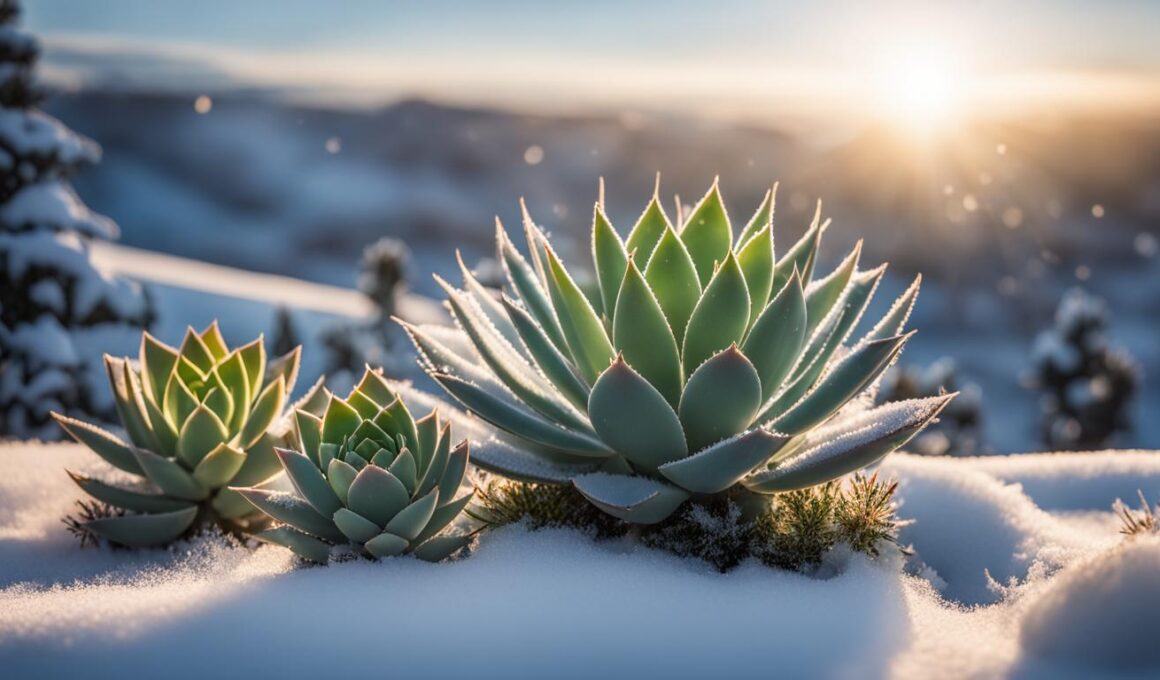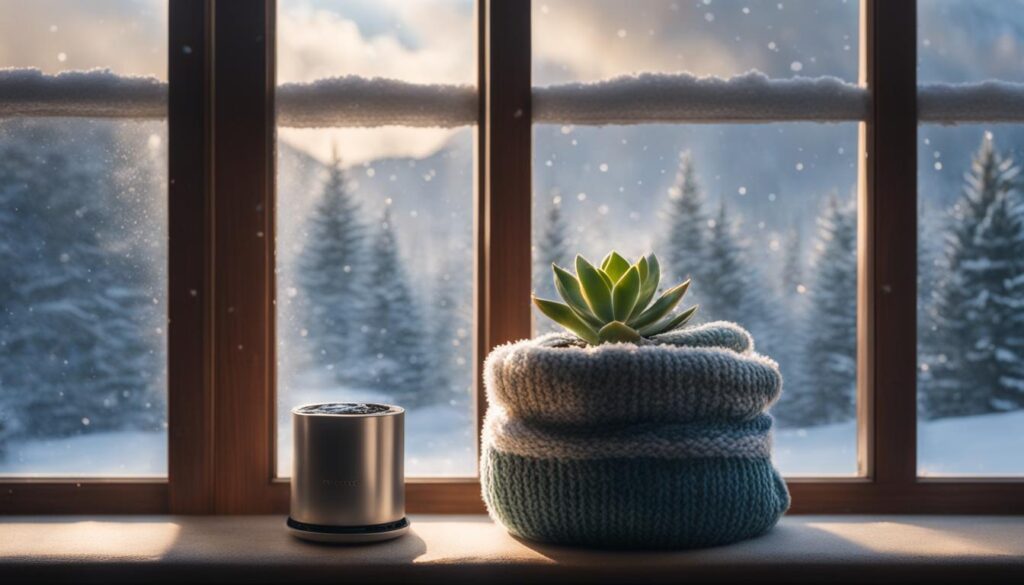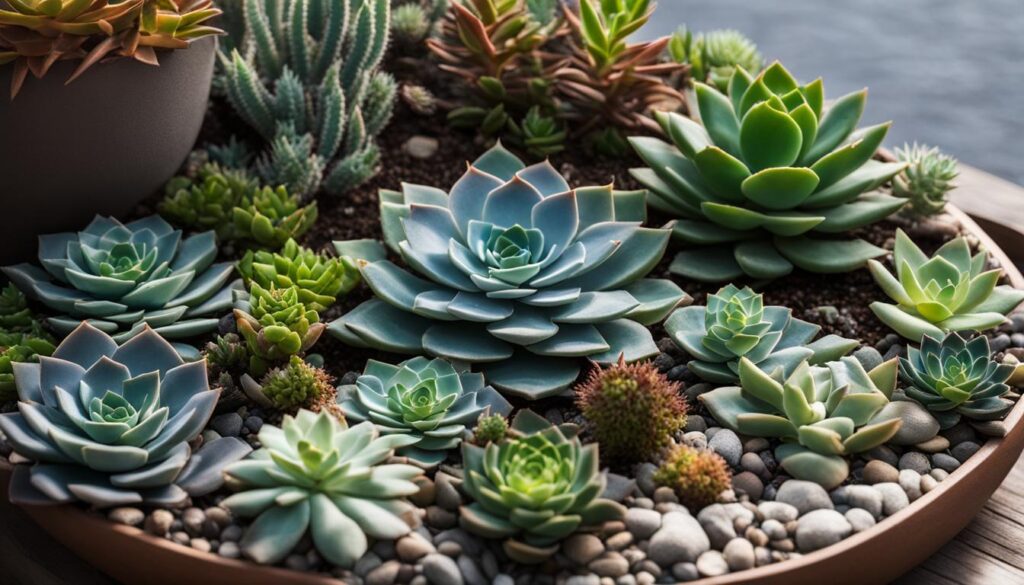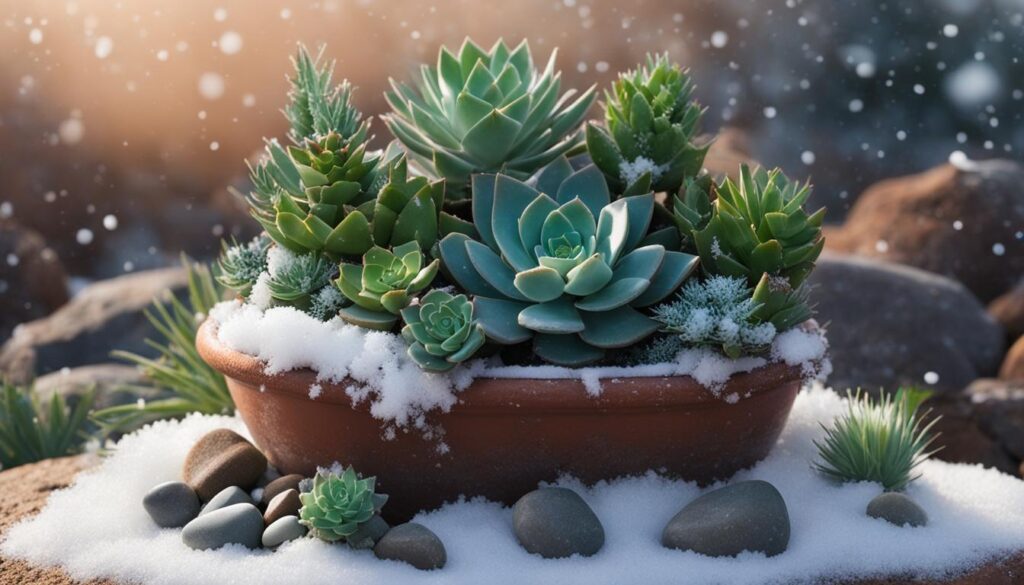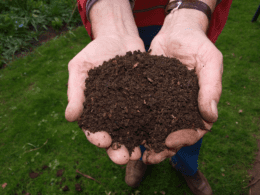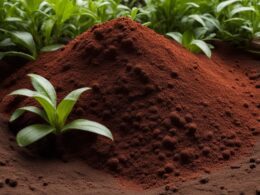When it comes to succulent survival in winter, the key is understanding the plant hardiness of your specific succulent species. Some cold-hardy succulents are more than capable of withstanding the harsh winter months, while others require special care and protection from the elements. This guide will help you determine which succulents can endure colder temperatures and provide you with tips for proper winter care for succulents to ensure their survival.
Key Takeaways
- Not all succulents can survive winter; their ability to do so depends on their plant hardiness and frost resistance.
- Cold-hardy succulents, such as Sempervivum, Sedum, and Euphorbias, can often survive temperatures as low as -20F (Hardiness Zone 5).
- Soft succulents are more sensitive to frost and require winterization indoors when temperatures fall below the freezing point.
- Understanding your succulent’s hardiness zone will help you determine which plants are suitable for year-round outdoor planting in your area.
- Proper winter care for succulents includes adjusting their soil, watering schedule, and light exposure, as well as providing protection from extreme cold.
- Knowing your succulent’s dormancy cycle is crucial for providing the appropriate level of care during cold months.
- With the right care and attention, your succulents can not only survive the winter months but also emerge healthy and ready for spring growth.
Introduction to Succulent Winter Survival
As temperatures start to drop, it is crucial to consider whether your succulents will be able to withstand winter conditions. Succulent survival during winter is possible with the appropriate care and preparation. Continuous support can be provided through a thorough guide, which includes contents such as knowing when to transition succulents indoors and tips for fostering their health through the colder months. Species like Echeveria, Crassula, and Aloe require frost protection, while others can survive slightly lower temperatures above 40F.
- Recognize the winter needs of your specific succulent species.
- Ensure appropriate temperature and lighting conditions.
- Adjust watering schedule and quantity based on winter requirements.
- Transition outdoor succulents indoors as necessary.
- Implement pest prevention measures to keep your plants healthy.
It’s important to understand the main factors that impact succulent care in winter. These include frost protection, indoors transition, and succulent winterization. By focusing on these factors, you can ensure that your succulents remain healthy and continue to thrive throughout the colder months.
| Factor | Importance | Tips |
|---|---|---|
| Frost Protection | Indispensable for preventing damage or death due to freezing temperatures. |
|
| Indoors Transition | Ensures a favorable environment for species that cannot tolerate colder temperatures. |
|
| Succulent Winterization | Involves adjusting care practices according to the species and season. |
|
By concentrating on these key factors and tailoring your care approach based on your succulent species, you can successfully navigate the challenges of winter and enjoy healthy, vibrant plants year-round.
The Science Behind Frost Resistance in Succulents
Succulents are categorized into hardy and soft varieties based on their frost resistance. Their survival outdoors during winter is determined by their ability to tolerate frost and below-freezing temperatures. Knowing your USDA Grow Zone, which is based on minimum winter temperatures, allows you to determine which succulents are suitable for year-round outdoor planting in your area and which ones need to be brought indoors as the climate cools.
Understanding Succulent Hardiness Zones
The United States Department of Agriculture (USDA) has established a system of hardiness zones to help gardeners identify which plants are likely to thrive in their region based on average minimum winter temperatures. These zones range from 1 to 13, with zone 1 being the coldest and zone 13 being the warmest. By knowing your USDA Grow Zone and the hardiness zone requirements of your succulents, you can make informed decisions about outdoor planting and winter care.
| USDA Grow Zone | Average Minimum Winter Temperature | Examples of Cold-Hardy Succulents |
|---|---|---|
| Zone 5 | -20°F to -10°F | Sempervivum heuffelii, Sedum telephium |
| Zone 6 | -10°F to 0°F | Sedum spurium, Sempervivum tectorum |
| Zone 7 | 0°F to 10°F | Euphorbia myrsinites, Sempervivum arachnoideum |
| Zone 8 | 10°F to 20°F | Sedum lejohnsonianus, Euphorbia cyparissias |
Characteristics of Cold-Hardy and Frost-Tolerant Varieties
Cold-hardy succulents, like Sempervivum heuffelii and certain Sedum varieties, excel in winter conditions and can even provide winter interest with their vibrant colors. These varieties have characteristics that enable them to survive light frosts and temperatures as low as 22°F. They typically require good drainage to prevent rotting, especially in melting snow, and need time to acclimate to cold weather if they have been grown in warmer conditions.
- Thick, waxy leaves: Many cold-hardy succulents have thick, waxy leaves which help them retain water while reducing frost damage.
- Dormancy period: These succulents often enter a period of dormancy in winter, reducing their need for water and nutrients and conserving energy for survival during colder months.
- Tolerance to fluctuating temperatures: Cold-hardy and frost-tolerant succulents are generally more adaptable to temperature fluctuations, allowing them to endure extreme weather conditions.
- Self-propagation: Succulents like Sempervivum are known to produce offsets or “pups” to ensure their survival even if the main plant succumbs to frost damage.
By understanding the science behind frost resistance in succulents and taking their hardiness zones into account, you can maximize the likelihood of your plants surviving winter temperatures outdoors and thriving year-round in your garden.
Preparing Your Succulents for Colder Weather
Winterizing succulents is essential to ensure their survival during the colder months. To prepare your outdoor succulents for winter, follow these guidelines to create a smooth indoor adaptation for succulents:
- Transition your outdoor succulents to well-draining soil and a pot with drainage holes. This promotes healthy root systems and airflow.
- Gradually reduce water intake in the weeks leading up to winter. This helps induce dormancy and prepares the plants for their indoor environment.
- Treat succulents with an insecticide spray to address any pest infestations before bringing them indoors. Pest prevention is crucial for maintaining the health of your indoor collection and minimizing the risk of disease transmission between succulents.
Once indoors, it is important to provide an optimal environment for your succulents to ensure they receive the care they need throughout winter:
- Keep the soil of your indoor succulents dry and water them sparingly. Water only when the soil has dried out completely, and take care to avoid overwatering.
- Maintain an indoor temperature between 50 and 60F for optimal winter dormancy conditions.
- Ensure adequate lighting by placing your succulents near a sunny windowsill or investing in a grow light setup if you live in an area with limited sunlight.
| Aspect | Outdoor Preparation | Indoor Adaptation |
|---|---|---|
| Soil Type | Well-draining soil | Dry soil |
| Watering Schedule | Gradually reduce water intake | Sparse watering, only when soil is dry |
| Pest Prevention | Insecticide spray treatment | Isolate new plants, monitor existing collection |
| Temperature | N/A | 50 – 60F |
| Lighting | N/A | Sunny windowsill or grow light setup |
By following these guidelines, you can prepare your succulents for the colder months and ensure their indoor adaptation is as smooth as possible. This will help your plants remain healthy and vibrant throughout the winter, so they are ready to thrive once spring arrives.
Identifying Your Succulent’s Dormancy Cycle
Most succulents enter a form of dormancy during winter, with varying degrees of inactivity. A portion goes into a deep dormancy and may even exhibit a die-back of above-ground growth, similar to deciduous trees. However, there are types like Aloe, Haworthia, and Aeonium that grow more actively in cooler temperatures and shorter days. Knowledge of your succulent’s dormancy cycle is key to providing the appropriate level of care, including reduced watering frequency and absence of fertilizers.
Winter Dormancy in Succulents Explained
Understanding the growth cycle of your specific succulent plants is essential for proper dormant succulents care during the winter season. Succulents can exhibit varying behaviors in response to lower temperatures, which is why it’s crucial to determine their dormancy patterns and adjust care accordingly. The following table lists common succulent genera and their dormancy periods:
| Genus | Winter Dormant | Winter Active |
|---|---|---|
| Echeveria | Yes | No |
| Crassula | Yes | No |
| Sempervivum | No | Yes |
| Aloe | No | Yes |
| Haworthia | No | Yes |
| Aeonium | No | Yes |
During their winter dormancy in succulents, it is important to adapt care strategies to prevent potential damage and prepare them for healthy growth come spring. Here are some essential care tips for dormant succulents:
- Reduce watering frequency: Dormant succulents will need less water during winter, so it’s essential to adjust your watering schedule accordingly, allowing the soil to dry out completely between waterings.
- Skip fertilization: Since your succulents are not in active growth, they won’t require any additional nutrients during the winter. Fertilizing dormant succulents can lead to weak, leggy growth and make them susceptible to pests and diseases.
- Monitor temperatures: Ensure that dormant indoor succulents are kept at a consistent temperature between 50 and 60°F for optimal dormancy conditions.
- Provide sufficient light: Although dormant, succulents still require suitable light sources to maintain health and avoid etiolation. Place them near a south-facing window or under a grow light for adequate light exposure.
By understanding the succulent growth cycle and adjusting care during winter dormancy in succulents, you can ensure that your plants remain healthy and vigorous, ready to flourish when the warmer months arrive once again.
Overwintering Strategies for Indoor and Outdoor Succulents
Overwintering succulents effectively depends on whether they are hardy outdoor varieties or soft indoor ones. Each type requires a unique approach to ensure the plants thrive during the colder months. Implementing proper variety selection and location-specific care adaptations is crucial for successful overwintering.
Frost hardy varieties suitable for outdoor overwintering may benefit from several protective measures. These steps help insulate the plants from extreme cold and snow:
- Transplanting succulents such as Sempervivum or hardy Sedums into the ground for better frost insulation.
- Ensuring the plants are in a well-draining planting area to prevent excessive moisture from accumulating in heavy snow or rain conditions.
- Providing a frost cloth or blanket as a barrier against frost, wind, or excessive rainfall.
- Grouping frost hardy succulents together to form a microclimate that provides shared protection against the elements.
Conversely, soft succulents should be relocated indoors during winter, with careful attention to the following factors:
- Light levels: Succulents need ample light to survive and thrive, so place them near a sunny windowsill or consider using grow lights when natural light is scarce.
- Air circulation: Good airflow is essential to prevent fungus and diseases. Maintain a comfortable distance between plants and avoid overcrowding.
- Watering practices: During winter months, provide minimal water as overwatering can lead to rot or fungal issues.
- Soil condition: Use well-draining soil to promote a healthy root system and reduce the risk of rot.
| Outdoor Succulents | Indoor Succulents |
|---|---|
| Transplant to the ground for better frost insulation | Relocate to a sunny windowsill or use grow lights |
| Ensure proper drainage to prevent excessive moisture | Maintain good air circulation to prevent fungus and diseases |
| Provide frost cloth or blanket for protection | Water sparingly during winter months |
| Group succulents together for a microclimate | Choose a well-draining soil |
By employing these overwintering strategies, your indoor and outdoor succulents can fare well through the cold months and emerge stronger and healthier as temperatures rise again in spring. Attention to detail and proper care adjustments are key in ensuring their successful transition through the colder season.
Tips to Help Your Succulents Thrive Through the Winter
As temperatures drop, it is crucial to pay extra attention to your succulents to ensure they survive the colder months. Indoor and outdoor succulents require specific care to make certain they remain healthy and flourish come springtime. Follow these tips to help your succulents thrive through the winter:
Optimal Indoor Conditions for Overwintering Succulents
To optimize indoor succulent care, place your plants near a sunny window or provide them with grow lights to ensure they get enough light during shorter winter days. Make an effort to consistently rotate the pots to avoid uneven growth in response to light.
Avoid overly heavy or compacted soil as it can lead to drainage issues and an increased risk of rot. Instead, use a light, gritty mix designed specifically for cacti and succulents to improve soil conditions.
Properly-adhered watering schedules are vital for indoor succulent care during winter. Water your succulents sparingly, allowing the soil to dry out completely between waterings. Note that winter growers, like Aeonium, Aloe, and Haworthia, may require more frequent watering and a different care approach.
Protecting Outdoor Succulents from Extreme Cold
For cold protection for succulents left outdoors, shelter them from excessive moisture by positioning them to receive morning sunlight. It helps keep them warm and prevents cold damage to the plant tissues. Keep in mind that hardy succulent varieties, like Sempervivum and Sedum, cope better with winter temperatures and may only need minimal cold protection.
Prevent rot and disease by regularly clearing away dead leaves. Align your watering habits with the natural moisture needs of your succulents, which are typically reduced during winter months for most varieties. Avoid overwatering, as it can cause damage or death to your plants.
Consider additional protective measures, such as snow insulation or clear rain covers for cold, wet winters without snow. These actions can help safeguard your succulents against the damaging effects of persistent moisture and promote their overall resilience to extreme cold conditions.
| Action | Indoor Succulents | Outdoor Succulents |
|---|---|---|
| Light Provision | Ample sunlight or grow lights | Morning sunlight for warmth |
| Soil Conditions | Light, gritty cactus & succulent soil | Well-draining soil |
| Watering Schedules | Sparingly with dry soil in between | Less frequent |
| Cold Protection | N/A | Snow insulation or rain covers |
By adhering to these tips and providing appropriate care for your indoor and outdoor succulents, you can ensure they remain in good health throughout the winter months, ready to flourish when spring arrives.
How Can I Protect my Basil Plants During Winter Like I would Succulents?
To protect the lifespan of basil plants during winter, mimic the care for succulents. Provide good drainage, limit watering, and place them in a warm, sunny spot. If moving them indoors, use a grow light to ensure they thrive. Protecting basil like succulents will help extend the lifespan of basil plants.
Conclusion: Ensuring Your Succulents Emerge Healthy in Spring
As the winter season comes to a close, your main objective is making sure your succulents reemerge strong and prepared for the spring growth period. Successfully winterizing your succulents depends on implementing proper care strategies, such as providing adequate light, adjusting watering schedules, and maintaining appropriate soil conditions. Focusing on these aspects during the coldest months helps secure the overall wellbeing of your unique plants, setting them up for a productive and healthy spring season.
By understanding and adhering to your succulents’ specific needs, you can prevent post-winter damage and ensure they bounce back in time for warmer weather. Monitoring their health and adjusting your care routine accordingly will optimize their resilience in fluctuating temperatures. This knowledge allows your succulents to transition seamlessly from their after-winter care routines and prepare them for the growth opportunities offered by the spring season.
Taking the time to invest in your succulents’ wellbeing, regardless of the climate or their dormancy cycles, ultimately results in thriving plants that can adapt to any environment. As a succulent enthusiast, your commitment to their success is the foundation of their seasonal readiness and long-term growth, contributing to the never-ending wonder and fascination these captivating plants provide.





